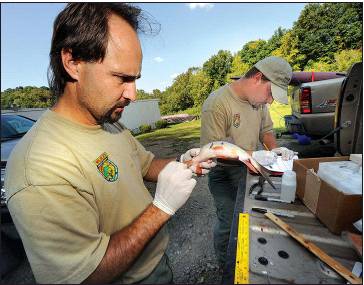DEP: Mine May be Fouling Dunkard
Group and DNR testing creek’s waters
Morgantown Dominion Post
17 September 2009
By Tracy Eddy
Officials think the pollutant killing hundreds of fish in Dunkard Creek
could be coming from the Blacksville No. 2 mine.
Kathy Cosco, spokeswoman for the West Virginia Department of
Environmental Protection (DEP), said investigators are still waiting
for test results, but their “hypothesis” right now is that the
pollutant is coming from an outlet at the mine.

West Virginia Department of Natural Resources
biologists Jim Hedrick (left) and Brandon Keplinger collect organ.
tissue and blood samples from a fish they pulled from Dunkard Creek
while investigating the source of the fish kill in the stream. Bob
Gay/The Dominion Post
“We have been talking to CONSOL,” she said. “They’re fully
cooperating with us on our investigation, and they are conducting an
investigation of their own.”
CONSOL Senior Vice President Tom Hoffman said they are still working
with the DEP to determine the cause of the problem. He said CONSOL has
not been told that the mine is definitely causing the problem.
Longwall production at the Blacksville No. 2 mine resumed in late
August after being idled for about two months because CONSOL saw a
decrease in demand for the coal it produced.
Investigators from CONSOL and the DEP continue to work to determine the
reason for the dying fish, Hoffman said, including looking at mine
discharge.
Hoffman said it is difficult to say what they would change if the mine
is the reason for the fish deaths.
“Until you know what the cause is,” Hoffman said, “you can’t have a
solution.”
Cosco said the DEP has tested the creek’s rust-colored water for
several things, including salinity, toxicity, a wide array of metals
and chemicals, such as pesticides and polychlorinated biphenyls.
The DEP is still waiting for the results of those tests, she said.
Residents who live along Dunkard Creek — in West Virginia and
Pennsylvania — have been noticing hundreds of dead fish and other
wildlife wash up along the banks of the creek since Sept. 3.
Since the summer started, Brian Brummage, of Pentress, has spent his
free time at Dunkard Creek with a rod and reel, trying to catch an
elusive 38-inch long muskie, he said.
The pollution got to it before Brummage could.
“I found it just laying up there,” he said. “I was pretty upset. It’s
just a shame. It’s killed everything here. There used to be bullfrogs
and whatnot, and now there’s just an orange creek.”
The pollution affects at least a 20-mile stretch of the creek.
Billy Craig, a member of the Mount Morris (Pa.) Sportsman’s Club board
of directors, said the club took water samples from three different
areas of the Dunkard Creek and is paying a lab in Pennsylvania to test
them.
Samples were taken from Dunkard Creek near where W.Va. 7 intersects
with the road that leads into Brave, Pa.; where Big Shannon Run meets
the Dunkard Creek; and at the Pigeon Hole in Bobtown, Pa., he said.
Fisheries biologists with the state’s Division of Natural Resources
(DNR) have also been trolling the creek, trying to figure out what
types of fish were affected by the pollution and how many have died
from it.
David Wellman, an assistant fisheries biologist, said the fisheries
biologists are taking organ, tissue and blood samples of the dead fish
and sending them to a DNR lab.
The DNR has been working with the West Virginia and Pennsylvania DEPs
to help pinpoint the cause of the pollution, he said, so the agencies
can start work on a cure.
Reporter Alex Lang contributed to this report.
